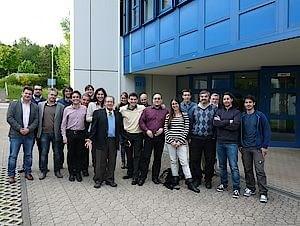NanoCom-Network
Advanced Processing and Characterisation of Micro and Nano Composites
FP7-PEOPLE-2009-IRSES – Grant agreement ID: 247524. https://cordis.europa.eu/project/id/247524
NanoCom-Network is an IRSES EU-Project which was developed between 1 June 2010 and 31 May 2013. “NanoCom-Network” was designed to develop cooperation between European and Latin American institutions in the field of advanced processing and characterization of micro and nano composites. The network was made up of 2 Universities in Europe (Universität des Saarlandes, Germany; and Technische Universität Wien, Austria), 1 Research Center (Helmholtz Zentrum Berlin, Germany) and 4 Institutions in Latin America (Centro Atómico Bariloche and Universidad Nacional de Río Cuarto in Argentina, Universidade de São Paulo in Brazil and Universidad de Concepción in Chile). In the second part of the project, also the European Synchrotron Research Facility (ESRF) in Grenoble participated of the Project.
The purpose of the project was to combine the different thematic specialties of different experts in the multidisciplinary field of materials science in order to design new composite materials with superior properties and performance.
During the project, a total of 38 exchanges were carried out comprising a total amount of 56 months and a total budget of about 88.000€ (this represented more than 95 % of the originally planned exchanges). As a result of this collaboration 18 peer review papers were published and 6 more are currently under revision. 9 contributions were also published in conference proceedings.
The following scientific achievements were obtained during the project for the different studied topics:
- Advanced design of Al-MMC and the study of the effects on the interfaces: different Aluminum-based MMCs (Al-Al2O3; Al-TiB2; Al-Zn; Al-Saffil) were successfully manufactured by different routes including liquid, semisolid and solid state processing. The processing parameters where optimized for the different systems, in order to obtain enhanced mechanical properties. These were determined meanly by a self-developed Small Punch Test technique. The interface between reinforcement and matrix was studied by TEM in order to analyze the stability of the phases.
- Advanced production and characterization of nano-structured bulk metal-ceramic composites: Fe matrices reinforced with WC was produced by sol-gel and by aqueous technique. The WC-grains presented sizes of several µm. The technique is now under optimization in order to reduce the size of WC-grains in order to achieve sub-µm sizes, which should improve the properties of the material.
- Advanced production and characterization of nano-structured coatings: Titanium carbonitride (TiCN) coating layers with star-shaped crystallite morphology were produced by chemical vapor deposition. The formation of such crystallite morphology was investigated and explained. This graded layers showed outstanding mechanical properties for the use as coatings for cutting tools. For improving the adhesion of the coating to the substrate, steel substrates were pretreated by increasing the amount of defects. The modification was done by Xe-peening. Synchrotron analysis showed that plasma nitriding reduces the compressive residual stresses of the TiN film, whereas Xe+ bombardment prior to plasma nitriding causes increased residual stresses in the TiN film.
- Modern characterization of MMC/3D characterization of MMC: The focused ion beam nanotomography technique, that allows direct three-dimensional investigations in materials, was applied for studying features as small as 10 nm, which is close to the resolution limits of this technique. Through this, quantitative characterization of mesopores in carbon materials as well as composites with reinforcements in the form of nanowires was achieved. FIB-sample preparation for Atom Probe as well as for TEM was optimized for the different composite materials. Specially for searching very low amounts of elements (e.g. Sr in AlSi and B in Steel) interfaces and precipitates.
Additionally to the original planned activities, several new cooperation lines among the partners where started within the project.
The final meeting of the projetc took place in Saarbrücken on 30 and 31 May 2013.
22 participants and organizers from Argentina, Brazil, Germany, Uruguay, Chile and Austria participated in the meeting and presented their results.




